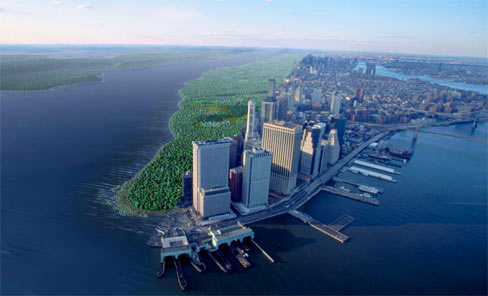Friday, March 30, 2012
The Manahatta Project.
The Manahatta Project
The Manahatta Project (currently under expansion as the Welekia Project) was launched in 2009 in conjunction with the 400th Anniversary of Henry Hudson's historic sail up the river that now bears his name in the rather diminutive but hearty sailing vessel known as the Half Moon.
The Project sought to "re-discover" the Island of Manhattan as Hudson might have encountered it that very first time, a lush verdant hilly landscape, dappled with brooks and ponds, inlets and beaches, cliffs and valleys, and the infamous swamp lands in the middle of the island we now know as Central Park. Anthropological studies were painstakingly researched to determine the vegetation and wildlife of four centuries ago, and after years of data collection, scientific speculation and historical cross-referencing, a map emerged: A map of Manahatta, the Island of Many Hills, the land of the Leni Lenape and Algonquin tribes, part of the Iroquois Nation.
Open the map (it requires Flash Player) and see Manhattan of 2009, the grid of streets and avenues where space seems impossible to find, where buildings abut one another in friendly chaos, where parks are beautiful but designed by the hands of men and carved out of nature, where the bottom half of the island is distinctly "fatter" than it had been after years of nonchalant landfill, broken piers, trash, grounded ships, and, more recently, well thought-out projects like Battery Park City, 90-acres of land added to the southwest corner of Manhattan after the original excavation of the first World Trade Center in 1968.
And underneath this present vision, see the Manahatta of 1609: A very different place, a place where millions upon millions of personal triumphs and tragedies would eventually play out among the diminishing trees and rearranged streams. But this project is not meant to make us weep for the past, but to rearrange our vision of Manhattan in the dawn of a new century.
We are thoroughly committed to our green spaces, and are, for example, in the very midst of a one-million-tree-planting project. We hope to add green spaces to the roofs of almost every building in Manhattan, and as we add bike lanes and widen esplanades, with fewer people in automobiles, we fully expect our city to look much more green again. A canopy of green under which will lie the city that we all love. The best of both maps.
I found this site fascinating and I hope you will as well, with all my best wishes.
Subscribe to:
Post Comments (Atom)

No comments:
Post a Comment